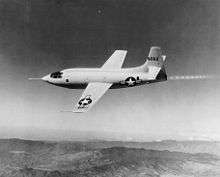Supersonic aircraft
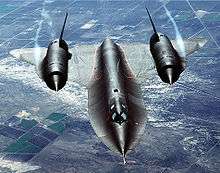
A supersonic aircraft is an aircraft able to fly faster than the speed of sound (Mach number 1). Supersonic aircraft were developed in the second half of the twentieth century and have been used almost entirely for research and military purposes. Only two, Concorde and the Tupolev Tu-144, were ever designed for civil use as airliners. Fighter jets are the most common example of supersonic aircraft.
The aerodynamics of supersonic flight is called compressible flow because of the compression (physics) associated with the shock waves or "sonic boom" created by any object travelling faster than sound.
Aircraft flying at speeds above Mach 5 are often referred to as hypersonic aircraft.
History
The first aircraft to fly supersonically in level flight was the American Bell X-1 experimental plane which was powered by a 6000-lb thrust rocket powered by liquid oxygen and ethyl alcohol.
The great majority of supersonic aircraft have been military or experimental aircraft.
In the 1960s and '70s, several projects for supersonic airliners were started and eventually two types entered service, the Anglo-French Concorde and the Russian Tupolev Tu-144. However political, environmental and economic obstacles and one fatal Concorde crash prevented them from being used to their full commercial potential and these aircraft are no longer flying.
Design principles
Supersonic flight brings with it substantial technical challenges, as the aerodynamics of supersonic flight are dramatically different from those of subsonic flight (i.e., flight at speeds slower than that of sound). In particular, aerodynamic drag rises sharply as the aircraft passes the transonic regime, requiring much greater engine power and more streamlined airframes.
Wings
To keep drag low, wing span must be limited, which also reduces the aerodynamic efficiency when flying slowly. Since a supersonic aircraft must take off and land at a relatively slow speed, its aerodynamic design must be a compromise between the requirements for both ends of the speed range.
One approach to resolving this compromise is the use of a variable-geometry wing, commonly known as the "swing-wing," which spreads wide for low-speed flight and then sweeps sharply, usually backwards, for supersonic flight. However, swinging affects the longitudinal trim of the aircraft and the swinging mechanism adds weight and cost, so it is not often used.
Another technique that has been used is a delta-wing design, such as used on Concorde. This has the advantage that it can attain a high angle of attack at low speeds, which generates a vortex on the upper surface which greatly increases lift and gives a lower landing speed. Other kinds of wings are the Short thin wing, Sweep back wing and the swept forward wing.
Heating
Another problem is the heat generated by friction as the air flows over the aircraft. Most supersonic designs use aluminium alloys such as Duralumin, which are cheap and easy to work but lose their strength quickly at high temperatures. This limits maximum speed to around Mach 2.2.
Most supersonic aircraft, including many military fighter aircraft, are designed to spend most of their flight at subsonic speeds, and only to exceed the speed of sound for short periods such as when intercepting an enemy aircraft or dropping a bomb on a ground target. A smaller number, such as the Lockheed SR-71 Blackbird military reconnaissance aircraft and the Concorde supersonic civilian transport, are designed to cruise continuously at speeds above the speed of sound, and with these designs the problems of supersonic flight are more severe.
Engines
Many early supersonic aircraft, including the very first, relied on rocket power to provide the necessary thrust, although rockets burn a lot of fuel and so flight times were short. Early turbojets were more fuel-efficient but did not have enough thrust and some experimental aircraft were fitted with both a turbojet for low-speed flight and a rocket engine for supersonic flight. The invention of the afterburner, in which extra fuel is burned in the jet exhaust, made these mixed powerplant types obsolete and none entered production. The turbofan engine passes additional cold air around the engine core, further increasing its fuel efficiency, and most supersonic aircraft have been powered by turbofans fitted with afterburners.
Supersonic aircraft usually use low bypass turbofans as they give good efficiency below the speed of sound as well as above; or if extended supercruise is needed turbojet engines are desirable as they give less nacelle drag at supersonic speeds.
Another high-speed powerplant is the ramjet. This needs to be flying fairly fast before it will work at all. The Pratt & Whitney J58 engines of the Lockheed SR-71 Blackbird operated in mixed modes, taking off and landing as turbojets, using the afterburner to accelerate to higher speeds when the inner jet core was shut down and all the air was fed round the bypass duct to the afterburner, so that the engine now operated as a ramjet. This allowed the Blackbird to fly at well over Mach 3, faster than any other production aircraft. The heating effect of friction at these speeds meant that a special fuel had to be developed which did not break down in the heat and clog the fuel pipes on its way to the burner.
Transonic flight
Airflow can speed up or slow down locally at different points over an aircraft. In the region around Mach 1, some areas may experience supersonic flow while others are subsonic. This regime is called transonic flight. As the aircraft speed changes, pressure waves will form or move around. This can affect the trim, stability and controllability of the aircraft, and the designer needs to ensure that these effects are taken into account at all speeds.
Hypersonic flight
Flight at speeds above about Mach 5 is often referred to as hypersonic. In this region the problems of drag and heating are even more acute. It is difficult to make materials which can stand the forces and temperatures generated by air resistance at these speeds, and hypersonic flight for any significant length of time has not yet been achieved.
Supersonic transports

A supersonic transport (SST) is a civil aircraft designed to transport passengers at speeds greater than the speed of sound. The only supersonic civilian aircraft to see service were the Soviet produced Tupolev Tu-144 which first flew in 1968 and was retired in 1997; and the Franco-British produced Concorde, which first flew in 1969 and remained in service until 2003. Since 2003, there have been no supersonic civilian aircraft in service.
A key feature of these designs is the ability to maintain supersonic cruise for long periods, so low drag is essential to limit fuel consumption to a practical and economic level. As a consequence, these airframes are highly streamlined and the wings have a very short span. The requirement for low speeds when taking off and landing is met by using vortex lift: as the aircraft slows, lift must be restored by raising the nose to increase the angle of attack of the wing. The sharply swept leading edge causes the air to twist as it flows over the wing, speeding up the airflow locally and maintaining lift.
Other SST projects have included:
- British – Bristol Type 223
- French – Sud Aviation Super-Caravelle
- US – Convair Model 58-9, Boeing 2707, Lockheed L-2000, Douglas 2229, SAI Quiet Supersonic Transport, High Speed Civil Transport
- USSR – Tupolev Tu-244, Tupolev Tu-444
- Russian-American – Sukhoi-Gulfstream S-21
Supersonic business jet

Supersonic business jets (SSBJ) are a proposed class of small supersonic aircraft. None has yet flown.
Typically intended to transport about ten passengers, SSBJs are about the same size as traditional subsonic business jets.
Projects for both large-scale and business jet (see lower) passenger supersonic and hypersonic airliners (Aerion SBJ, Spike S-512, HyperMach SonicStar, Next Generation Supersonic Transport, Tupolev Tu-444, Gulfstream X-54, LAPCAT, Reaction Engines A2, Zero Emission Hyper Sonic Transport, SpaceLiner, etc.) were proposed and now are under development.
Supersonic strategic bombers
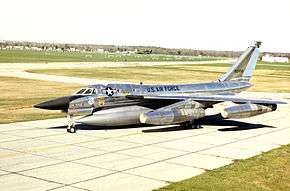


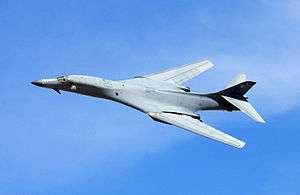
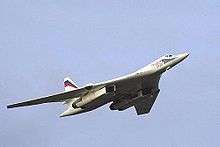
A strategic bomber must carry a large bomb load over long distances, consequently it is a large aircraft typically with an empty weight exceeding 25,000 kg. Some have also been designed for related roles such as strategic reconnaissance and anti-shipping strike.
Typically the aircraft will cruise subsonically for most of its flight to conserve fuel, before accelerating to supersonic speed for its bombing run.
Few supersonic strategic bombers have entered service. The earliest type, the Convair B-58 Hustler, first flew in 1956 and the most recent, the Rockwell B-1B Lancer, in 1983. Although this and a few other types are still in service today, none remains in production.
Other types to have flown include:
- Tupolev Tu-22 (1959)
- Myasishchev M-50 (1959)
- North American XB-70 Valkyrie (1964)
- Tupolev Tu-22M (1969)
- Sukhoi T-4 (1972)
- Tupolev Tu-160 (1981)
- Rockwell B-1B Lancer (1986)
Out of these, only the Tu-22, Tu-22M, B-1B, and Tu-160 entered production. A next-generation stealthy supersonic strategic bomber is being planned in United States under the 2037 Bomber project.
Supersonic strategic reconnaissance
Some supersonic strategic bombers, such as the Sukhoi T-4 are also capable of the reconnaissance role (although the Sukhoi remained a prototype).
The Lockheed SR-71 Blackbird was specifically designed for the role, and was a larger development of the Lockheed A-12 attack aircraft which first flew in 1962.
Supersonic fighter/attack jets
Supersonic fighters and related aircraft are sometimes called fast jets. They make up the overwhelming majority of supersonic aircraft and some, such as the Mikoyan-Gurevich MiG-21, Lockheed F-104 Starfighter and Dassault Mirage III, have been produced in large numbers.
Many military supersonic fighters and similar aircraft of fourth- and fifth- generations are under development in several countries, including Russia, Japan, South Korea, India, Iran and the United States.
 United States
United States
- Douglas F4D Skyray (1951)
- North American F-100 Super Sabre (1953)
- Convair F-102 Delta Dagger (1953)
- McDonnell F-101 Voodoo (1954)
- Lockheed F-104 Starfighter (1954)
- Republic F-105 Thunderchief (1955)
- Vought F-8 Crusader (1955)
- North American F-107A (1956)
- Convair F-106 Delta Dart (1956)
- North American A-5 Vigilante (1958)
- McDonnell Douglas F-4 Phantom II (1958)
- Northrop F-5 Freedom Fighter/Tiger II (1959)
- General Dynamics F-111 Aardvark (1964)
- Grumman F-14 Tomcat (1970)
- McDonnell Douglas F-15 Eagle (1972)
- Northrop YF-17 Cobra (1974)
- General Dynamics F-16 Fighting Falcon (1974)
- McDonnell Douglas F/A-18 Hornet (1978)
- Northrop F-20 Tigershark (1982)
- Northrop YF-23 (1990)
- Lockheed Martin F-22 Raptor (1997)
- Lockheed Martin X-35 (2000)
- Boeing X-32 (2000)
- Lockheed Martin F-35 Lightning II (2006)
 Soviet Union/
Soviet Union/ Russia
Russia
- Mikoyan-Gurevich MiG-19 (1953)
- Mikoyan-Gurevich MiG-21 (1955)
- Sukhoi Su-7 (1955)
- Sukhoi Su-9 (1956)
- Sukhoi Su-11 (1958)
- Yakovlev Yak-28 (1958)
- Yakovlev Yak-27 (1960)
- Tupolev Tu-28 (1961)
- Sukhoi Su-15 (1962)
- Mikoyan-Gurevich MiG-25 (1964)
- Sukhoi Su-17 (1966)
- Sukhoi Su-24 (1967)
- Mikoyan-Gurevich MiG-23 (1967)
- Mikoyan MiG-27(1970)
- Yakovlev Yak-38 (1971)
- Mikoyan MiG-31 (1975)
- Sukhoi Su-27 (1977)
- Mikoyan-Gurevich MiG-29 (1977)
- Sukhoi Su-33 (1987)
- Yakovlev Yak-141 (1987)
- Sukhoi Su-30 (1989)
- Sukhoi Su-34 (1990)
- Sukhoi Su-37 (1996)
- Sukhoi Su-47 (1997)
- Mikoyan Project 1.44 (2000)
- Mikoyan MiG-35 (2007)
- Sukhoi Su-35 (2008)
- Sukhoi PAKFA/T-50 (2010)
 Sweden
Sweden
- Saab 32 Lansen (1952)
- Saab 35 Draken (1955)
- Saab 37 Viggen (1967)
- Saab JAS 39 Gripen (1988)
 United Kingdom
United Kingdom
- English Electric Lightning (1954)
 France
France
- Dassault Mirage III (1956)
- Dassault Mirage IV (1959)
- Dassault Mirage F1 (1966)
- Dassault Mirage 5 (1967)
- Dassault-Breguet Super Étendard (1974)
- Dassault Mirage 2000 (1978)
- Dassault Mirage 4000 (1979)
- Dassault Rafale (1986)
 China
China
- Shenyang J-6 Farmer (1958)
- Nanchang Q-5 Fantan (1965)
- Chengdu J-7 Fishbed (1966)
- Shenyang J-8 (1969)
- Nanchang J-12 (1970)
- Xian JH-7 Flounder (1988)
- Chengdu J-10 Vigorous Dragon (1998)
- Shenyang J-11 (1998)
- Nanchang/Hongdu L-15 (2005)
- Shenyang J-15 Flying Shark (2009)
- Chengdu J-20 stealth (2011)
- Shenyang J-16 (2012)
- Shenyang J-21/J-31 Gyrfalcon (2012)
 Canada
Canada
- Avro Canada CF-105 Arrow (1958)
 West Germany
West Germany
- EWR VJ 101 (1963)
 Egypt
Egypt
- Helwan HA-300 (1964)
 Italy
Italy
- Aeritalia F-104S (1966)
 United Kingdom/
United Kingdom/ France
France
- SEPECAT Jaguar (1968)
 Japan
Japan
- Mitsubishi T-2 (1971)
- Mitsubishi F-1 (1975)
- Mitsubishi F-2 (1995)
 Israel
Israel
- IAI Nesher (1971)
- IAI Kfir (1973)
- IAI Lavi (1986)
- IAI Nammer (1991)
 West Germany/
West Germany/ United Kingdom/
United Kingdom/ Italy
Italy
- Panavia Tornado (1974)
 South Africa
South Africa
- Atlas Cheetah (1986)
 Republic of China
Republic of China
- AIDC F-CK-1 Ching-kuo (1989)
 European Union
European Union
- Eurofighter Typhoon (1994)
 Iran
Iran
- HESA Azarakhsh (1997)
- HESA Saeqeh (2004)
 India
India
- HAL Tejas (2001)
 Republic of Korea
Republic of Korea
- KAI T-50 Golden Eagle (2002)
 China/
China/ Pakistan
Pakistan
Supersonic research aircraft
- Bell X-1 (1946), first to break the sound barrier in level flight. Rocket powered.
- Douglas D-558-2 Skyrocket (1948) Rocket powered.
- Convair XF-92 (1948) First delta-wing supersonic jet.
- Bell X-2 (1952) Rocket powered.
- Fairey Delta 2 (1954), first to exceed 1,000 miles per hour.
- North American X-15 (1959), first hypersonic aircraft and spaceplane. Rocket powered.
- Martin Marietta X-24A (1969) Rocket powered.
See also
References
- Bibliography
- Gunston, Bill (2008). Faster than Sound: The Story of Supersonic Flight. Somerset, UK: Haynes Publishing. ISBN 978-1-84425-564-1.
